The Middleweight Adventure Triad

KTM 790 Adventure R v. BMW F 850 GS Adventure v. Triumph Tiger 900 Rally Pro
It’s been said dozens of times, many different ways. The definition of adventure is unique to the person defining it. Like fingerprints, no two answers will be identical. Case in point: the KTM Adventure 790 R, BMW F 850 GS Adventure, and Triumph Tiger 900 Rally Pro. These bikes make up three-quarters of the burgeoning middleweight adventure category. These motorcycles comprise a niche within a popular category, yet within a few miles of riding each bike, it’s remarkable just how differently each brand approaches the task. The core philosophy of each marque shines through in these machines and plainly portrays how its part of the world, and the people riding there, define adventure.
Get the Flash Player to see this player.
This aspect alone actually makes the comparison more enjoyable. You don’t have to split hairs. There won’t be a winner and a loser, simply different bikes for different riders. There are pretty well-defined lines for each motorcycle and the customers they were built for. Even the Tenere 700, which is absent from this test because… Yamaha, is geared toward a fourth type of customer who may have different requirements than the other three.
When we asked each manufacturer for its “Adventure” or “R” model, I didn’t anticipate that that request would so clearly highlight the defining characteristics of what adventure meant to each bike’s respective makers.
BMW F 850 GS Adventure
BMW has long had a stranglehold on the large displacement adventure bike category with bikes like the venerable R 80/100/1100/1200/1250 GS’s. Heck, some would argue BMW started the whole thing. And although the big Boxers generate more sales for the company, BMW (and KTM, for that matter) has been a player in the middleweight adventure game since the 1990s. BMW’s first Single cylinder 650 “Funduro” made it stateside in 1997, the same year KTM introduced its 640 Adventure model.
Fun fact: The first BMW F650 was designed by BMW and Aprilia jointly. Aprilia manufactured the bike in Italy with an Austrian Rotax 652cc Single engine. Remember when we could all just get along?
2019 BMW F 850 GS And F 750 GS Review – First Ride
BMW’s middleweight adventure bike line was originally made up of the Single 650s mentioned above before the 700 and 800, now 750 and 850, Twins eventually graced dealership floors. This latest iteration of F 850 GS is powered by an 853cc parallel Twin engine that, according to our official MO dyno, cranks out 80.5 hp at 9,660 rpm and 50.6 lb-ft of torque at 7,430 rpm. The motor makes smooth power all the way up to the rev limiter. Smooth, that’s a good descriptor for the F 850 GS Adventure.
For $1,100 more, the Adventure model gets increased fuel capacity from 4.0 to 6.1 gallons, an extra inch of travel in the front fork, a two-way adjustable windscreen that, in conjunction with the absolutely bulbous front end, provides the most wind protection out of our trio, three seat options (rally, double, or low), engine crash bars, and a rear luggage mount. As for ride modes, cruise control, ESA, and other acronyms and niceties, those are still all upgraded through the same Essential ($550), Select ($1,550), and Premium ($2,250) packages available to the standard F 850 GS. In order, to get the F 850 GS Adventure close to the same level with all of the features found on the Triumph Tiger 900 Rally Pro, one would have to opt for the Premium package which, in addition to things like ride modes Pro, cruise control, quickshifter, TPMS, and heated grips, BMW gives the option of low suspension or its Dynamic ESA (Electronic Suspension Adjustment) – which applies only to the shock, the 43mm fork remains non-adjustable. So, to really compare apples to apples, the F 850 GSA would be ringing up for $17,540 to bring it on par with the Tiger 900 Rally Pro in terms of features.
Alas, I think we had the (mis?)fortune to test one of the few nearly base models that BMW decided to import into the US. I’ve been told at many a BMW press introduction that BMW NA generally doesn’t plan to bring many base model GS’s stateside because their customers usually want features included in one of the three packages offered. Hey, we all have to make money somehow.
But what’s it like to ride back to back with the other two middleweights in this comparo? Let’s bring it back to the word smooth. On the freeway, at 80-plus, the F 850 GS Adventure rides like a ’60s Cadillac, complete with that boat-like floaty feel as the plush suspension eats up road imperfections before they ever make their way through the cush seat to your backside. With a 5’8” rider, the BMW’s rider triangle is nearly perfect while pounding out the miles, if only for the footpegs to seem slightly high after jumping off of the KTM or Triumph. The monstrous front end – which is almost entirely made up of plastic without much fuel tank or anything else essential behind it – coupled with the adjustable windscreen, does a fantastic job of punching a train-sized hole in space giving the rider the most wind/weather protection of the three bikes tested.
Guest tester and former MOron, Tommy “Guns” Roderick concurred, “The BMW is comfy with the best wind protection of the three. Part of this stems from the bike’s ultra-wide styling. Sharing a family resemblance with its larger sibling the R1200GS Adventure is one thing, but the girth of this middleweight motorcycle is enough to make a GoldWing blush.”
And then we took it off-road…
I’ll let Tom reveal the 552 lb elephant in the room: “The GS is the heaviest of the group by a lot, and you can feel every pound of extra weight when the riding gets dirty. Even when adjusting for the extra gallon of fuel it carries, the BMW is 85 pounds heavier than the KTM. On the bright side, it carries its weight well, or as well as it can considering its too-soft suspension, so that helps.”
Tom’s spot on. The BMW’s weak point is its suspension. Like I mentioned previously, we tested a mostly stock 850 GSA which has a 43mm non-adjustable fork and a standard shock adjustable for preload via a remote handwheel and rebound. Although the Adventure model gains an additional inch of travel from the fork, it blows through the stroke so quickly it hardly matters. Unfortunately, this wasn’t only a problem when our ace-in-the-hole guest tester, AMA Supersport and dirt track champ, Eric Bostrom was ripping the 850 off-road. The Beemer suffered the same issues when trying to unwind a tight set of curves on the asphalt too.
When Eric pulled in from his final photo pass on the BMW after flogging the Triumph and KTM for the camera, the first thing out of his mouth was, “This thing is actually hazardous to your health.” To be fair, Eric later admitted he may have been a bit harsh on the F 850, but he’s not totally out of line. If you plan to do serious off-roading on your middleweight adventure bike, the BMW F 850 GS Adventure simply isn’t the bike to do it with. If your plan is to pound out the miles on pavement and graded fire roads, and you’re okay keeping the pace slow and steady once the going gets tricky, the 850 GSA will fit the bill just fine. Plus, you’ll be able to go some 270 miles between fill ups.
“Besides Eric Bostrom riding the hell outta this thing in the dirt, I fail to see how this motorcycle really qualifies as an adventure bike. Sure, it has a 6.1-gallon fuel tank for making it further down the road compared to the other two in this shootout, but its suspension is too soft for any type of riding outside of smooth freeway cruising. Rubbing salt in the wound is the non-adjustable attribute of the fork.” –Thomas J. Roderick
KTM 790 Adventure R
KTM changed the middleweight adventure game in early 2019 with the release of the 790 Adventure R, and the entire adventure segment felt the shockwave.
The Austrian brand is, of course, not new to getting it done in the dirt. KTM has been bringing home the gold since 1956 in off-road competition. The orange marque now has more than 260 world championships to its name including 18 consecutive Dakar rally wins and four of the last five AMA Supercross titles (2018 went to Husqvarna so…). That alone should give some substance to the company’s “Ready to Race” slogan, and that DNA is interwoven in KTM’s production line up as well.
2019 KTM 790 Adventure R First Ride Review
Ya know, being Ready to Race isn’t everything in the adventure touring world. Despite Wes Van Nieuwenhuise finishing fourth in the 2020 Sonora Rally on a 790 Adventure R, it also needs to be able to tour, right? Well, I guess that depends how you define adventure. This KTM is basically the anti-BMW. Where the F 850 GSA is pleasant and cush and capable of crushing long days in the saddle, the 790 ADV R begs you to explore off-piste every chance you get, from fire roads to single track, the rougher the going gets, the better the KTM performs.
For $1,000 over the standard 790 Adventure, the R model lands you WP’s fully-adjustable 48mm XPLOR fork and PDS shock, both of which offer 9.4 inches of travel (1.5 inches over the standard model), a smaller windscreen and higher fender, Michelin Karoo 3 tires, and the all important Rally riding mode. The R model without the quickshifter+ (a $300 option) that we had fitted on our test bike rings up as the cheapest of the bunch at $13,699.
As if KTM’s off-road pedigree wasn’t enough to give the 790 R a leg up on the competition between the three, the Michelin Karoo 3s definitely lend an advantage off-road. As was the plan for this sort of preliminary three outta four comparison, we wanted the Adventure/R/Rally Pro models sent to us just as a customer would purchase them off of the showroom floor. It is worth noting that while BMW offers the zero-cost option of off-road tires (something similar to the Karoo 3) being fitted from the manufacturer, we received the F 850 GSA with its street-bias Michelin Anakee 3s. The Triumph Tiger comes off the showroom floor shod with Bridgestone Battlax Adventure A41, also clearly a street-biased tire. Once we have the Yamaha Tenere 700 in our clutches, the plan will be to fit the same tires across all four models to get a better idea of their dirt performance on equal footing. KTM’s choice of a 21/18-inch wheel combo also adds to its off-road prowess.
That being said, the tires weren’t what made the biggest difference off-road. The WP XPLOR suspension, which was previously found on KTM’s EXC-F models, has excellent bottoming resistance and, in its stock compression and rebound settings, is a great middle of the road set up for canyon carving and riding off-road, whether we’re talking miles of sand or rocky trails.
In my opinion, the KTM 790 Adventure R’s real advantage is just how well the sum of its parts work together. The compact LC8c 799cc parallel Twin engine, svelte chromoly trellis frame, WP XPLOR suspension, and low-slung fuel tank make the 790 Adventure R feel even lighter than the 467 lbs we saw on the official MO scales. With its weight kept so low, the 790 R feels nearly effortless when tiptoeing around technical sections of trail, and manages to keep its composure as the speeds ramp up while bombing down the odd fire road.
Here’s what T-Rod had to say, “KTM has transformed itself into a street bike powerhouse, but at its core, the company remains a dirtbike manufacturer. So, it’s no surprise that, when it comes to producing a middleweight adventure bike with a true off-road riding pedigree, the 790 Adventure R gets it done better in the dirt by a large margin over the other two adventurers here. It’s combination of light weight, well-balanced adjustable suspension, and one of the best parallel-twin engines I’ve ever had the pleasure riding make the KTM formidable off the road or on.”
There are a fair amount of electronics available on all three of these bikes, but, in my opinion, the 790 Adventure R gets the nod for having the most functional due its Rally mode set up. When in Rally mode, the 790 Adventure R allows you to choose between three throttle maps, depending on how responsive you’d like the throttle. The rider is also able to flip between nine levels of traction control on the fly with the left switchgear. On the Tiger, the traction control setting is tied to each ride mode and cannot be adjusted further. The BMW keeps traction control separate from the ride modes as well and is either off or on. The KTM and the BMW allow traction control adjustment on the fly.
ABS is set independently from the ride modes. The 790’s Road mode is the ABS setting the motorcycle reverts to every time it’s switched on via the key or kill switch and includes cornering ABS. Offroad ABS allows the rear wheel to lock up and disables cornering ABS. With a long push and hold of the button, Off is off. All of the bikes are capable of disabling ABS entirely while stopped.
Keeping with the anti-850 theme here, the KTM feels more competent the faster you go. Where the BMW starts to make one nervous as the pace ramps up or the trail narrows, the KTM keeps asking for more with a chassis that has the capability to perform.
Of course, the dirtbike style ergos, long flat(ish) seat, and small non-adjustable windscreen don’t do the 790 Adventure R any favors when it comes to long hauls on the freeway. Cruise control is available as an option on both the KTM and the BMW, but the Tiger 900 comes with it standard. The KTM Powerparts catalog says $85 for the new control module that includes the cruise control switch, you’ll then need a dealer to plug in the bike to activate it.
“Where the KTM will suffer some deficiencies is during long-haul street rides where the slimmer seat and lack of wind protection will cause more discomfort than the other two bikes. But if my main purpose in life is riding as little pavement as possible because the real adventure begins where the pavement ends, then the KTM is the obvious choice.” –T. Roderick
During our Zoom chat, Tom also put it thusly, “If my goal is to ride 200 miles of pavement for 50 miles of dirt, the KTM’s not the choice, but for 50 miles on the street and 200 miles off-road, the KTM’s better set up for it.”
Triumph Tiger 900 Rally Pro
“This adventure bike is juuuust right,” Goldilocks, 1837. For those looking for an option between the KTM and BMW, look no further than Triumph’s newest adventure model, the Tiger 900 Rally Pro. The Rally Pro sits atop Triumph’s five Tiger 900 trims as the most adventurous of the bunch. With significant updates to the chassis and engine, the new Tiger 900 is by far the most potent Tiger yet, and in this company, it’s hard to beat as the best all around.
2020 Triumph Tiger 900 GT Pro & Rally Pro Review – First Ride
The Tiger 900 Rally Pro differs from the other Tiger trims with its 21/17-inch (tubeless) wheel combo, 45mm Showa fork and shock providing 9.5 inch and 9 inches of travel, respectively, Off-road Pro riding mode, fog lights, and engine protection. The Rally Pro is also fitted with all sorts of touring niceties that are also found on the GT Pro model.
The Tiger 900’s new Triple engine is now lighter and more compact which, combined with the new T-plane crank, gives the motor a more lively and exciting power output. The 888cc Triple actually pumps out nearly identical performance figures as the KTM with 84 hp peaking at 8,900 rpm and 57 lb-ft of torque at 6,300. The Tiger 900 has the smoothest dyno chart of the three with its broad torque curve reaching 50 lb-ft before 3,000 rpm.
At $16,700, the Triumph Tiger 900 Rally Pro is the most expensive model (as tested) here, but it also offers touring accoutrement in spades over the others. Heated grips, heated seats (happy passenger, happy life), cruise control, an adjustable windscreen, a brilliant 7-inch TFT display that’s easily navigated with a joystick on the left switchgear, Bluetooth connectivity for communication devices, phones, and GoPros, and a USB outlet under the seat.
The Tiger 900’s quickshifter (up and down) was much smoother than the KTM’s, even between first and second gear, and our BMW wasn’t fitted with one. I thoroughly enjoy blasting down fire roads at speed using the quickshifter. Bang a couple downshifts and pitch the bike into the corner as the slipper clutch tries to match the rear wheel speed to the engine, and a big smile comes over your face every time you get things right. Of course, when things don’t pan out exactly how you hoped, the Tiger 900’s stability feels almost like a safety net. It’s only when the going gets technical or really fast that you’re reminded of the bike’s 503-pound wet weight.
Triumph gave the Tiger 900 top-of-the-line stopping components to get you slowed down confidently off-road and on. Brembo Stylema calipers, steel-braided brake lines, and a J.Juan master cylinder provide excellent stopping power and feel. Both the Triumph and the KTM come with cornering ABS while it’s optional for the BMW. Due to our KTM’s front brake feeling inconsistent, like there was air in the lines, we didn’t get a great back to back test during our shoot. That being said, I’ve ridden each of these motorcycles separately, and while stopping power is better than adequate on all three, the Tiger 900’s binders are on an entirely different level.
Back to that big ol’ TFT screen. BMW was the first company we saw using a TFT dash mated to the exterior glass which provides a vivid display no matter the lighting conditions. The Triumph’s display is visually stunning and can be tweaked between four different styles. The screen is easily navigated and, in my opinion, is the most intuitive of all three machines tested. All three bikes have auto-contrasting features built into their TFT displays to adjust with ambient lighting.
On the street, the Triumph is pretty handily the best touring machine in terms of rider comfort and features. The slight letdown comes from the Rally Pro’s wide and just a tad too far forward handlebar. While standing off-road, the handlebar position is great, but while seated, the stretch to the bars had even our tallest tester, T-Rod, canted forward, “The Triumph’s seating position does leave a bit to be desired. The handlebars seem positioned a little further away than necessary forcing the rider to lean forward rather than sitting upright.” The handlebar position can actually be adjusted further forward, if one sees fit.
Off-road, the Tiger 900 Rally Pro handles itself quite well. Again, it was only once the speeds ramped up that the big cat started to show any weaknesses. The fork, while offering ample travel and good feedback, seems overly harsh in the initial stroke. After you get through the slow initial damping, the action speeds up. We didn’t have much time to play with the settings, but with the ability to adjust preload, rebound and compression, I’m pretty confident you could get the damping a little more dialed in fairly easily. The shock suffers the same qualms, albeit not as noticeable. Eric had this to say, “When you get into a little bit more technical riding or some large g-outs, you’re going to run out of suspension on the thing. It ends up feeling a little soft for doing aggressive dirt riding.”
The Tiger has six ride modes: Rain, Road, Sport, Off-road, Off-road Pro, and Rider (customizable). What’s slightly annoying about the ride mode set up is that you can only select between the first three mentioned while moving. Even though Off-road mode doesn’t entirely disable ABS, you still have to be stopped to switch into Rider, Off-road, and Off-road Pro. The latter of which makes more sense because it disables TC and ABS entirely. Given that annoyance, one nice feature is the large warning/reminder that is shown when you start the bike saying that it will revert back to Road mode. It also gives the option of a single click to bring the bike back into the mode it was in when the bike was shut off.
While riding the Tiger off-road, I managed to stall the bike more than either of the other two machines. Shaving all of that weight off of the engine internals makes for a great free-spinning engine feel on road, but without much flywheel weight, you’ll need to be ready to feather the clutch sliding in and out of corners.
Tell us how you feel, Tom: “As outfitted the Triumph’s tires are street biased for sure. Mount some more dirt-aggressive rubber and the Triumph will hold its own against the KTM. The Tiger carries 36 more pounds compared to the KTM’s 467 wet weight figure, but it’s my opinion that if you’re looking for the most all-around capable motorcycle of this group the Triumph does the best job of offering the same level of street and dirt abilities.”
“The Tiger is a really nice intermediate package. The Triumph was really impressive. It was dirt-able while being really nice on the street. I think it’s a great bike for adventurous street rides, some mixed terrain, and you can go down fire roads on that thing all day.” –Eboz
Surprise
Or not. I don’t think the outcome of this comparison was really a surprise to anyone involved. It’s pretty clear what these three motorcycles offer adventure riders. As said before, each machine is unique to a certain kind of motorcyclist. Each manufacturer represented here has a history of building fantastic machines that motorcyclists around the world enjoy riding.
BMW’s touring capabilities are world renowned and legendary. Triumph’s aggressive push these past few years to provide excellent motorcycles with absolutely top notch fit and finish with the latest and greatest technology and components has been a trend we’re happy to see continued with the Tiger 900. KTM’s no-apologies take on providing the ultimate dirt-worthy middleweight adventure bike that’s as Ready to Race as nearly anything else in its lineup redefined the capabilities of modern adventure bikes.
Make Life a Ride | Ready to Race | For The Ride
And then there’s Yamaha. Stringing the world along for years with the Tenere 700. Fortunately, I did have the chance to ride the Tenere 700 at the global introduction in Spain a year ago. I can say it is yet another option that ticks entirely different boxes for adventure seekers.
I can’t wait to get the Yamaha and this band back together, on equal footing and head out on a real adventure, post COVID restrictions, of course. Keep your eyes set on the horizon. We’ll be back with the next adventure soon enough.
Middleweight Adventure Shootout ScoreCard | ||||
|---|---|---|---|---|
BMW F850GS Adventure | KTM 790 Adventure R | Triumph Tiger 900 Rally Pro | ||
Price | 89.6% | 100% | 82.0% | |
Weight | 84.6% | 100% | 92.8% | |
lb/hp | 81.2% | 100% | 93.3% | |
lb/lb-ft | 75.2% | 100% | 93.2% | |
Total Objective Scores | 84.1% | 100% | 89.4% | |
Engine | 87.9% | 93.8% | 91.7% | |
Transmission/Clutch | 86.7% | 81.7% | 90.0% | |
Handling | 75.0% | 90.8% | 85.0% | |
Brakes | 76.7% | 79.2% | 84.2% | |
Suspension | 50.0% | 90.8% | 78.3% | |
Technologies | 78.3% | 85.0% | 95.0% | |
Instruments | 88.3% | 86.7% | 95.0% | |
Ergonomics/Comfort | 84.2% | 82.5% | 82.5% | |
90.0% | 89.2% | 90.0% | ||
Cool Factor | 76.7% | 88.3% | 88.3% | |
Grin Factor | 70.0% | 93.3% | 90.0% | |
Ryan’s Subjective Scores | 79.2% | 89.2% | 89.8% | |
Tom’s Subjective Scores | 79.6% | 85.0% | 88.5% | |
Eric’s Subjective Scores | 79.2% | 89.6% | 87.1% | |
Overall Score | 80.3% | 90.3% | 88.7% | |
Specifications | BMW F850GS Adventure | KTM 790 Adventure R | Triumph Tiger 900 Rally Pro |
|---|---|---|---|
| MSRP | $14,445 ($15,290 with Rally color option) | $13,699 | $16,700 |
| Engine Type | Fuel-injected, liquid cooled, four-stroke Parallel-Twin engine, four valves per cylinder, double overhead camshafts, dry sump lubrication | Fuel-injected, liquid-cooled, four-stroke Parallel-Twin, four valves per cylinder, double overhead camshafts, forced oil lubrication with two oil pumps | Fuel-injected, liquid-cooled, 12-valve, DOHC, inline 3-cylinder |
| Bore x Stroke | 84 mm x 77 mm | 88.0 mm x 65.7 mm | 78.0 mm x 61.9 mm |
| Capacity | 853cc | 799cc | 888cc |
| Horsepower | 80.5 hp at 9660 rpm (measured) | 84 hp at 8320 rpm (measured) | 84 hp at 8940 rpm (measured) |
| Torque | 50.6 lb-ft. at 7430 rpm (measured) | 57.3 lb-ft. at 6720 rpm (measured) | 57 lb-ft. at 6300 rpm (measured) |
| Compression Ratio | 12.7 : 1 | 12.7:1 | 11.3:1 |
| Transmission | Constant-mesh 6-speed gearbox with straight cut gears | 6-speed | 6 speed |
| Final Drive | Chain | Chain | O-ring chain |
| Frame | Tubular steel space frame , load bearing engine | Chromium-Molybdenum-Steel frame using the engine as stressed element, powder coated | Tubular steel frame, bolt-on subframe, double-sided, cast aluminum alloy swingarm |
| Front Suspension | 43mm upside-down telescopic fork, 9.1 inches of travel | WP XPLOR 48mm fork, fully adjustable, 9.4 in. travel | Showa 45 mm upside down forks, manual preload, rebound damping and compression damping adjustment, 9.45 inches travel |
| Rear Suspension | Cast aluminum 2-sided swing arm, WAD strut (travel related damping), spring pre-load hydraulically adjustable (continuously variable) at handwheel, rebound damping adjustable, 8.5 inches of travel | WP XPLOR PDS shock, fully adjustable, 9.4 in. travel | Showa rear suspension unit, manual preload and rebound damping adjustment, 9.06 inches wheel travel |
| Front Brake | Dual floating disc brakes, two-piston floating calipers, diameter 305 mm, ABS | Dual 320 mm discs, radial-mount 4-piston J Juan calipers, ABS | Twin 12.6-inch floating discs, Brembo Stylema 4-piston monobloc calipers. Radial front master cylinder, Optimized Cornering ABS |
| Rear Brake | Single disc brake, diameter 265 mm, single-piston floating caliper, ABS | Single 260 mm disc, two-piston J Juan caliper, ABS | Single 10-inch disc. Brembo single-piston sliding caliper. Optimized cornering ABS |
| Wheelbase | 62.7 inches | 59.4 inches (60.2 inches) | 61.1 inches |
| Rake/Trail | 28°/4.9 inches | 25.9°/4.2 inches | 24.4/5.7 inches |
| Front Tire | 90/90-21 54V | 90/90-21 Michelin Karoo 3 | 100/90-19 90/90-21 |
| Rear Tire | 150/70-17 69V | 150/70-18 Michelin Karoo 3 | 150/70R17 150/70R17 |
| Seat Height | 34.4 inches (Standard Seat) | 34.6 inches | 33.5-34.3 inches |
| Wet Weight | 552 lbs (measured) | 467 pounds (measured) | 503 pounds (measured) |
| Fuel Capacity | 6.1 gallons (Approx. 0.9 gal reserve) | 5.3 gallons | 5.3 gallons |

Ryan’s time in the motorcycle industry has revolved around sales and marketing prior to landing a gig at Motorcycle.com. An avid motorcyclist, interested in all shapes, sizes, and colors of motorized two-wheeled vehicles, Ryan brings a young, passionate enthusiasm to the digital pages of MO.
More by Ryan Adams



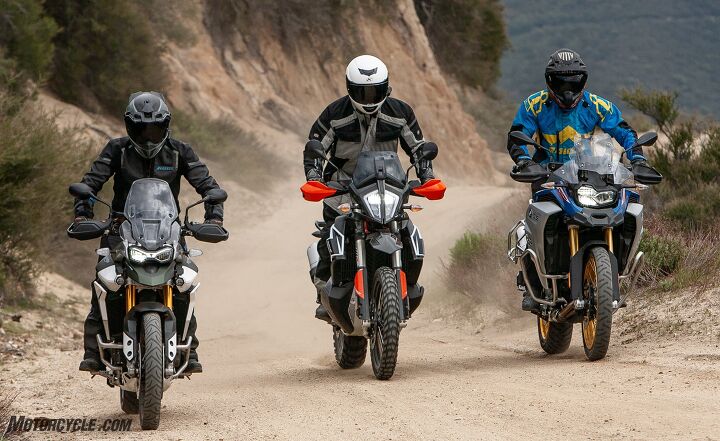
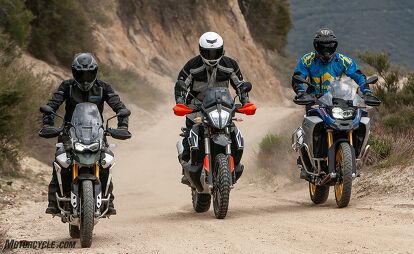
















































































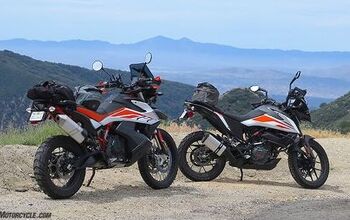
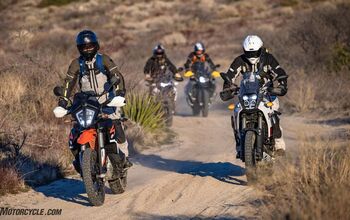
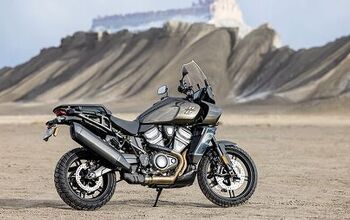












Comments
Join the conversation
The engine in the BMW is made in China.
So it looks like the $3k price diff between the KTM and Triumph buys you things like a centerstand, better wind protection, cruise control, and a lot of other electronic touring farkles? And I assume you'd have to immediately replace the seat on the KTM with a Seat Concepts unit? But the Triumph would need better dual-sport tires right away and a real bash plate, maybe some other protection?